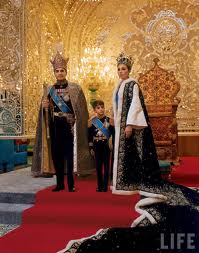
Preparing for Class:
November 14

Persepolis,
pp. 18-79
- How does the title, "The
Water Cell," focus our attention in the first chapter of this section?
How does Satrapi use this motif to reveal something about both Marji and the
country's history?

- What's the purpose of the flashback
history of the rise of the Pahlavi shahs? Who are the people controlling that
revolution? What's their interest in Iran?
- How is this narrative echoed and
strengthened by Marji's lesson in her own family history?
- In "Persepolis," Grandma
continues the story of the rise of the current Shah. How does the chapter
title comment on the coronation of the Shah Reza Pahlavi?
- On p. 29, we have a collage of
Marji's father's photographs, taken illegally at demonstrations. Why is this
an effective way to tell a complicated story without any words?
- On p. 33, Marji finally reveals
why she's ashamed of riding in her father's cadillac; what's the reason? How
does this lead into the central narrative of "The Letter"?
- Who is Mehri and how does she
come to live with Marji's parents?
- As you read this story, pay careful
attention to the choices made by Mehri, Mehri's sister, Marji's father, and
Hossein, the neighbor's son. What does each person's choice reveal about him/her?
Were you surprised by anyone's actions?
- What do you think Marji, still
a young child, learns from the whole episode?
- What happens when Marji and Mehri
go to a demonstration?
- On p, 42, we have a full page
illustration of people (no veils) celebrating the overthrow of the Shah, but
on the opposing page at the bottom is an illustration of Marji and her family
watching television coverage. Her father says, "Let's enjoy our freedom,"
and her mother responds, "Now that the devil has left." What kind
of comment is implied by the frame around this picture?
- What do you think motivates Marji's
foray into revenge and torture? How does her mother deal with it?
- The heros are Siamak Jari and
Mohsen Shakiba. What are their histories? How does each affect Marji? What
is her response to them?
- What finally happens to Siamak
and Mohsen?
- Why include Marji's conversation
with Laly on p. 48?
- It does seem everything revolves
around Marji in this account, which is pretty typical of the way a child sees
the world. How does the return of the two imprisoned heroes cause a shift
in the way Marji sees her father?

- Who's Uncle Anoosh and what's
his story?
- What insight into 20th century
Iranian history does he provide?
- Why do Marji's friends think she's
lying when she tells them about her grandfather, Uncle Anoosh and Uncle Fereydoon?
- As Marji's parents and Uncle Anoosh
denounce the Islamic Revolution and the media coverage of it, what's going
on at school with Marji and her friends?
- Why don't her parents want to
leave Iran, even as their friends and fellow revolutionaries are dying or
narrowly escaping the police?
- What do you see as the effects
on ten-year-old Marji of her uncle's death (note the picture on p. 71, for
instance)? How many traumatic experiences has she had recently?
- What then happens to her mother
that is very scary for the entire family?
- When the schools are closed in
preparation for their re-opening as fundamentalist Islamic institutions and
in the demonstrations under the Islamic Republic the reprisals are more violent
than the ones under the Shah, Marji and her parents go to Italy and Spain.
Why go now? What do you see as significant about this trip?
- When they get home, Grandma has
some news--and Marji defines a new identity for herself. What is it?
Return to Daily
Readings and Assignments Page
Return to Home
Page




